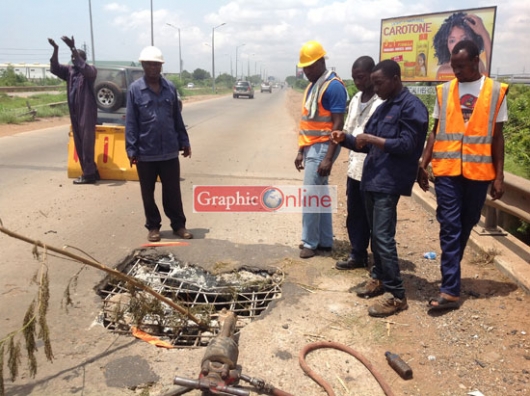 A major bridge on the Accra-Tema Motorway has almost caved in, causing heavy vehicular traffic on the road.
A major bridge on the Accra-Tema Motorway has almost caved in, causing heavy vehicular traffic on the road.
The situation has prompted the Ghana Highway Authority (GHA) to close part of the bridge to traffic from Tema to Accra for repair works.
As an interim measure to manage the vehicular traffic, the GHA has created a diversion near the bridge, which is close to the Old Abattoir.
When the Daily Graphic visited the scene Wednesday, officials from the Mobile Maintenance Unit (MMU) of the GHA in Suhum in the Eastern Region were busily assessing the situation for repair works to begin.
Efo Kwame Botse, a senior official of the MMU, told the Daily Graphic that the unit and the Bridge Maintenance Unit at Kukurantumi had been assigned to repair the bridge.
He could not indicate how long the repair works would take, but said the main pre-occupation of the rehabilitation gang for the moment was to divert traffic for work to start as soon as possible.
Efo Botse cautioned drivers and other road users from the Tema end of the motorway to approach the works area with caution to avoid any accidents.
He gave an assurance that the maintenance team would work as fast as possible to ensure that the repair works were undertaken with little effects on all road users.
Background
The Accra-Tema Motorway, the 19-kilometre stretch of highway linking Accra with Ghana’s industrial and manufacturing hub, Tema, was one of the numerous prestigious projects conceived and built by the first President of Ghana, Osagyefo Dr Kwame Nkrumah.
The project formed part of the Seven-Year Development Plan (1963-1970) of the CPP government to transform the economic and material conditions of the people.
The main feature of the motorway is a dual carriageway with a median or central reservation area which separates the two carriageways which terminate at both ends with a toll booth.
For more than 30 years, the motorway has not undergone any major rehabilitation, leading to the development of numerous potholes which have caused accidents and traffic congestions.
The development of potholes was primarily due to the use of the road by vehicles loaded with cargo exceeding the permissible axle load weight for the highway.
In addition, lack of reflectors, breakdown of vehicles and unsafe bridges make driving on the highway in the night unsafe.
However, in 2002, the Kufuor administration attempted to provide street lights for the Motorway to abate the crime rate on it.
The project was to commemorate Ghana’s Golden Jubilee, but it was suspended due to cable thefts.
In 2009, the Mills government undertook the rehabilitation of the motorway at a cost of GH¢500,000, with part of it being constructed with epoxy mortar cement which dried in three days.
The eight-week exercise also involved the replacement of concrete slabs which had developed potholes and the repair of the asphalt surface on the shoulders of the road.
The motorway, however, still remains a pale shadow of its former self, as more work is needed to be done to transform it into a first-class highway.
Source: Daily Graphic


